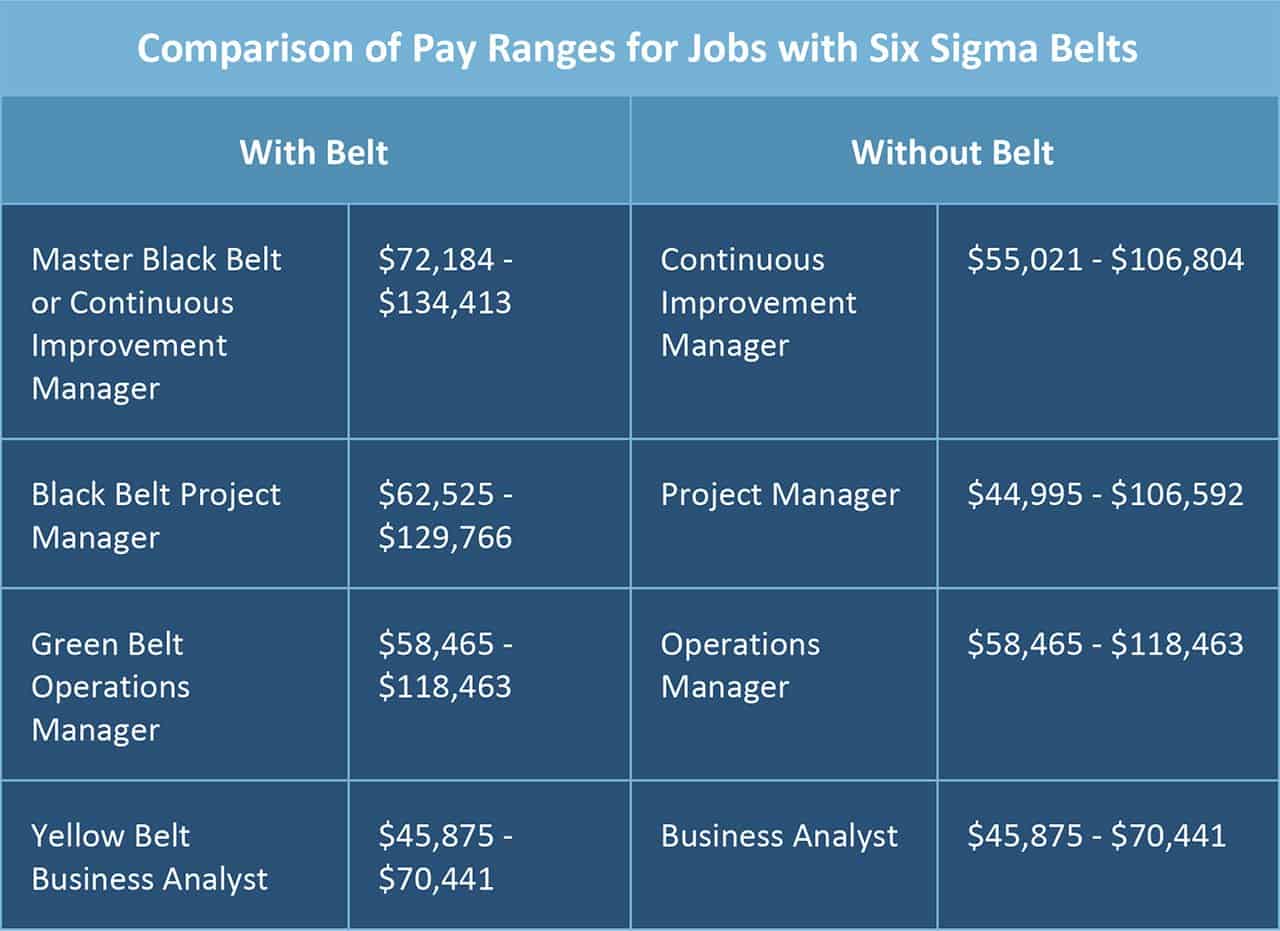Data-based decision-making is what business leaders expect from their management team, rather than reactive decision-making. Six Sigma is now becoming a corporate management system foundational aspect. The move to management is no longer acceptable; the market is simply too competitive. Learning Six Sigma is a best way to achieve this goal, and senior leaders realize that they need to be effective and efficient. Before you decide to set your foot into this domain, let us know in details about the career opportunities for Six Sigma Green Belt.
Let us analyze Six Sigma Green Belt Career aspects!
About Six Sigma Green Belt
A Six Sigma Green Belt professional is an individual that possesses a thorough understanding of enhanced problem-solving skills, with an emphasis on the DMAIC (Define, Measure, Analyze, Improve and Control) and QFD model.
A Six Sigma – Green Belt Professional assesses the candidate as per the company’s need for deploying, managing and maintaining quality systems. A certification in six sigma tests the candidates on various areas in lean and six sigma principles, DMEA, QFD, collecting and summarizing data, statistical analysis and process control.
Why to learn Six Sigma Green Belt?
There are several reasons for which you should get a certification in Six sigma green belt or should know why to choose your segment . Only a good certification can provide you a good knowledge of this segment. Some of them are listed below –
- The main reason for getting this is to advance your career. With this certification or knowledge about this, employers have an explicit ability to provide support. Employment competition can be tough. You can distinguish yourself from the crowd by demonstrating that you are aware and can apply lean six sigma.
- You will get a thorough understanding of the measurement and the quantification of financial benefits after you get Six Sigma training. You are ready for leadership roles with six Sigma training courses. You become a good leader with the technology and know-how to cut costs and boost revenue. You learn ways to make the business process more efficient.
- The Six Sigma certification process is not managed by an authorized organization. The current certification and training contributes to an improvement culture. It also helps to manage processes. Lean and six sigma voices a similar language those who are aware and trained. You understand better the steps needed to remedy a process and reduce waste.
- You will be able to measure, analyze, monitor and improve. You will also be able to conduct an assessment of existing processes. Their impact on quality performance you get very clear knowledge. You will also develop the ability to continuously improve the quality required by the organization. You can closely monitor the processes to confirm that there is no deviation from the average.
So, above mentioned reasons are sufficient enough to see how beneficial six sigma green belt is for you as well as for the organization.
How can you start your career in Six Sigma Green Belt?
It is very much important to have a decent beginning with proper assets and learning material to be acceptable at something. Therefore, you initial steps towards learning must be apt in order to be pro in this field. Let look at some steps that you can take in order to begin your learning process –
Step 1 – Learn about the basics and Develop Conceptual understanding
It is very important that you have a strong foundation before you become an expert in certain fields. Even before you reach the pragmatic laboratories, an appropriate applied information is required. Somewhere everybody begins. If you want a successful career in this domain, you have to take baby steps. You can use the following resources to gain full knowledge and understand the concept –
- Firstly, Online Tutorials for Six sigma green belt
- Also, Certification Courses from verified sources such as Vskills, Coursera, Udemy and so on.
- In addition, Online communities
- Moreover, Blogs and study material from experts in this field and many more.
Vskills also provide Online tutorials, certification courses and free practice tests for the same. You can check them out on our official site.
Step 2 – Practice Mini Projects
If you want to land in a good place, practicing is essential. It is also a best way to understand and to know where you stand when it comes to implementing your knowledge. With regard to practical aspects such as the implementation of six sigma green belt principles in projects, experience can help you outlive other aspects. With reading the blogs and tutorials, you can supplement your learning by different sites to understand the practical aspects more effectively.
Step 3 – Build Your Portfolio
Building you portfolio will help you gain confidence about your skills and will also get you a platform to implement your learnings. Your portfolio shows your abilities to carry out and plan various codes or how impeccably you execute your abilities in selenium. These tasks ought to incorporate a few diverse datasets and should leave readers with intriguing bits of knowledge that you’ve gathered. Your portfolio needn’t bother with a specific subject; find codes that interest you, at that point think of an approach to assemble them.
Step 4 – Implement your skills in Real world
It is very important to implement your skills because that is why you have learned to do this perfectly! It is also important that you stay up-to-date and continue to work and develop your own skills. Some of the advanced courses also show you know advanced skills. You can also attend. Some ways to achieve your skills are –
- Freelancing
- Internships
- Apprenticeship programs
Above mentioned steps will help you to get started in this domain. However, there is a long way to go. You can take up an advanced course to take your skills to a new level.
Applications of Six Sigma Green belt
Green belts are competent team players whose objective is to improve the quality of the process. They help bridge the gap between Six Sigma theory and the application in the real world. In order to improve the process, data inspections or project management, six candidates from Sigma Green Belt play a crucial role. Green Belt Training teaches candidates the basic tools of a project team and the application of DMAIC skills for a Six Sigma project.
Career opportunities in Six Sigma Green Belt
Job duties vary by industry, but most Green Belt jobs focus on improving processes, managing projects, and analyzing data. Jobs for professionals with Six Sigma Green Belt certification include:
Six Sigma Advisors In order to analyse the current processes, challenge the business assumptions and make recommendations for changes that improve workflow and reduce waste, 6 Sigma consultants cooperate with operations using their project skills and business abilities.
Engineer Process In order to evaluate internal procedures with a view to efficiency and quality, process engineers support a business leadership. A process engineer had a median salary of $70,876 in 2016.
Engineer of production The processes used for the design, construction and delivery of products are developed, optimised by production engineers. To solve problems and continuously improve the production processes, Six Sigma Green Belt uses its knowledge of lean methodiology.
Specialist in Continual Improvement Specialists for continual improvement (CI) identify and coordinate initiatives for continuous improvement with data collection and analysis of root causes. CI experts make advice and share their conclusions with the leadership of a company.
Engineer of quality In order to ensure that products from a company meet customer standards, quality engineers are responsible. This role is typically played by professionals with day-to-day operations and long-term improvement planning.
Manager for Operational Excellence Operational excellence managers report to senior managers and work with team members at all levels to manage the Lean Six Sigma initiatives of an organisation.
Engineering Industry In order to better use employees and the other resources to improve operations, industrial engineers evaluate production rates, product flow and quality control processes. For an industrial engineer, the average salary was $63,58 in 2016.
Concept covered in Six Sigma Green Belt
The scope of six sigma green belt is very wide. However, The list of topics across D-M-A-I-C framework, that are normally covered in Six Sigma Green Belt are as follows:
- firstly, Change Management
- Also, KANO Model, SIPOC diagram
- furthermore, Process capability, Segmentation and Stratification, Sampling strategy
- also, Measurement System Analysis, Project charter, Voice Of the Customer (VOC) to Critical-To-Quality (CTQ)
- furthermore, Box Plot, Process Map
- in addition, Pareto, Concept of LEAN, Hypothesis Testing, Rolled Throughput Yield (RTY)
- subsequently, Correlation, Mistake-proofing, FMEA
- in addition, Fishbone Diagram, Normality study, Statistical Process Control (SPC)
- moreover, Process Management Charts, Data Collection Plan (DCP)
- lastly, Run Chart, Control Chart, Regression
What are the deliverables expected from you on the job?
There are many responsibilities you are entrusted with when you get a good job. Some of the obligations you are expected to meet are –
- Leading project team Six Sigma enhancement.
- Works in the Six Sigma Black Belt under supervision.
- Analysis and resolution of problems of quality.
- I took part in a project but did not conduct a project
- Coordinate your project with the data collection team and validate the system
- Green belts work in their own functional area in general.
- Can improve your training skills for your team.
- Project charter development and SIPOC (supplier, input, process and output) project diagram.
Market Demand
Earning The Six Sigma Green Belt Certification can help you to earn valuable career opportunities in various companies across the globe. There is a great demand of certified lean six sigma professionals across the domains. Companies like Accenture, Sodexo, KPMG, Wipro, Myntra, Oakland, IBM etc. are having good demand for certified professionals.
Average Salary
According to PayScale.com, the average salary for a Six Sigma Green Belt salary for 2017 was roughly between $65,000 and $79,000 per year. According to Indeed.com, the national average salary for a Certified Green Belt Professional is $72,000 per year in the United States. Find differences in the salary level of people with and without six sigma belts. Eventually the people who have this certification end up having good opportunities and more job opportunities as well. s per research by Salary.com, last done as of April 27, 2020, the average Six Sigma salary in United States is ranging from $84,800 to $1,10,400.

Conclusion
Professionals are asked to set SMART objectives and then apply the Six Sigma principles to them. To complete this, three main areas are examined; learning, performance and performance.
Actually, nobody ever understands an ultimate phase. It’s a journey and an ongoing process. Don’t postpone your work area with the deployment of Lean Six Sigma. If you have not all bits in place or not all tools have been trained. Begin today with the process.
Get started and discover the career opportunities in the field of Six sigma green belt. Hurry up and try free practice tests now offered by Vskills.in!





